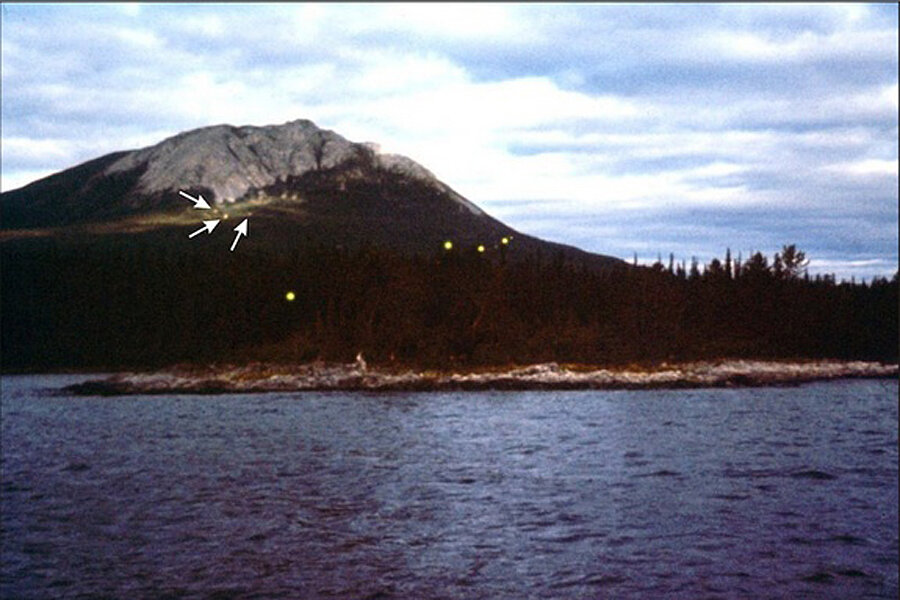Scientists unravel mysterious 'earthquake lights'
Loading...
Mysterious flashes of electricity known as earthquake lights are more likely to happen near rifts, where pieces of the Earth are pulling away from each other, new research suggests.
The quick buildup of stress at these nearly vertical faults may cause electrical current to flow to the surface and cause the eerie light shows, the researchers find.
The conclusions, published today (Jan. 2) in the current issue of the journal Seismological Research Letters, were drawn from analyzing 65 documented cases of earthquake lights over the last 400 years.
Elusive phenomenon
These strange light shows, which can look like flickering flames or floating, glowing orbs, according to those who have observed them, have occurred during or before several of the world's greatest earthquakes, including two days before the Great San Francisco Earthquake of 1906.
But until recently, most seismologists didn't believe the earthquake lights were real because the reports were all anecdotal and hard to explain physically. [The Top 10 Unexplained Phenomena]
"Earthquake lights are totally underreported," said study co-author Friedemann Freund, a crystallographer at the NASA Ames Research Center in Mountain View, Calif., and San Jose State University. "They are often things that happen within a fraction of a second."
There's not always a person around to see them and when they do report them, they were often discounted by scientific journals, Freund said.
The advent of better documentation and video cameras has changed that. For instance, just before the earthquake that struck L'Aquila, Italy, in 2009, bystanders reported flames flickering up from the pavement. Video and eyewitness reports also described several weird light anomalies during the magnitude-8.0 earthquake in Pisco, Peru, in 2007. In one case in the early '70s, luminous drifting globes thought to be possible UFOs when they were observed in Canada's Yukon Territory later were linked to earthquake lights.
Origin of lights
But exactly why these lights happen was still a mystery. To get at the question, Freund and colleagues looked at documents dating back to 1600 for reports of earthquake lights.
The team found 65 cases that were well documented from North and South America and Europe. Of those cases, 97 percent seemed to happen at faults within continental plates, rather than at subduction zones, or the boundaries where one plate is diving below another. That's despite the fact that most big earthquakes happen at subduction boundaries.
Instead, about 85 percent of the time, lights seemed to happen at places where the tops of the continental plates buckle, creating fissures, or rifts, where the Earth pulls apart.
"You have two sides of a piece of continent are pulling apart and in the middle there's a part that just falls vertically down," often by miles over millions of years, Freund told LiveScience.
These rifts form steep, nearly vertical faults that stretch deep into the Earth's magma, allowing primitive magmatic rocks that were once deep below ground to migrate closer to the Earth's surface.
The authors think that because of the crystal structure of these magmatic rocks, when stressed they are likelier to generate electricity, which then flows to the Earth's surface, ionizes the air, and produces flashes of light.
The earthquake lights also appeared at other nearly vertical faults, for example, the strike-slip San Andreas fault. These faults likely make it easier for electrical charges in these dark magmatic rocks to reach the surface, said study co-author John Derr, a seismologist at the Albuquerque Seismological Laboratory.
Many unknowns
Still, the distance from the epicenter of the quake, and the timing of the light show, can be very different. Sometimes, earthquake lights aren't even associated with earthquakes, Freund said.
That's because electrical current can flow from a stress buildup that could either be released in a catastrophic rupture, or gradually over several days, with no quakes.
Two of the earthquake lights noted in the records appeared near subduction zones, but they may actually have been caused by hidden, nearly vertical faults within the subduction zone that are buried under water or layers of sediment, Freund said.
With many subduction zones out in the deep ocean, it's likely that more earthquake lights are reported near intraplate faults, since that's where people live. But even if the flashing lights did form out in the ocean, the water would dampen the electricity and prevent the lights from emerging, Freund said.
It’s not clear exactly why subduction zones don't seem to be good locations for these earthquake lights, but one possibility is that nearly vertical faults are better at transferring stresses formed deep below the Earth to the surface, said Patrick Hogan, a project manager at NASA's World Wind project in Mountain View, Calif., who was not involved in the study.
Follow Tia Ghose on Twitter and Google+. Follow LiveScience @livescience, Facebook & Google+. Original article on LiveScience.
- 7 Most Dangerous Places on Earth
- Images: One-of-a-Kind Places on Earth
- Image Gallery: This Millennium's Destructive Earthquakes
Copyright 2014 LiveScience, a TechMediaNetwork company. All rights reserved. This material may not be published, broadcast, rewritten or redistributed.







